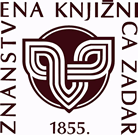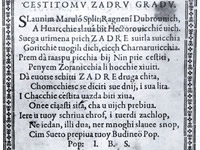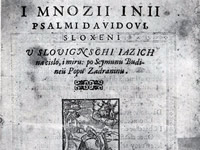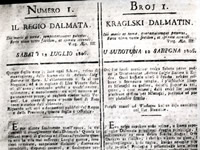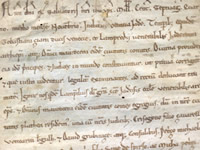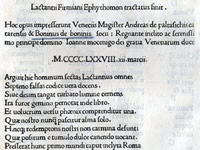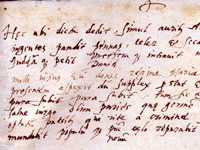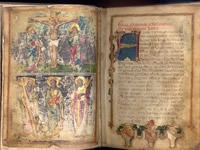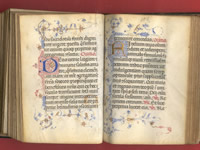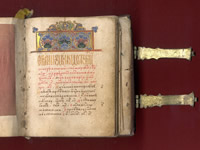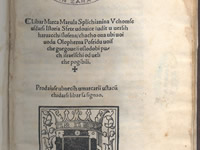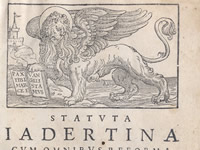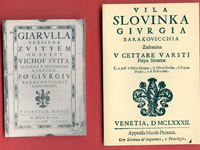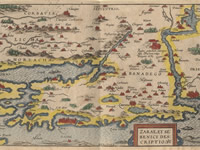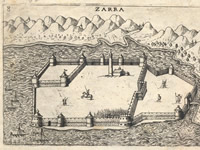On account of its cultural treasure and diversity of materials, the Research Library is one of the most important Croatian libraries. As a general research type of library it possesses literature from all areas of human knowledge, and is of equal interest to students and scholars as well as researchers.
It inherited 55 719 volumes of varied library materials from the Paravia library. After World War II it was enriched with books from the so-called Collection Centre, with collections of books from various institutions, schools, courts, and valuable private collections. In 1949 it gained the right to a deposit copy of all Croatian printed matter. In addition to deposit copy, the holdings were enriched with purchase and donations. Nowadays the Library has about 530 000 volumes of books, with as many as about 1000 volumes of books printed in 16th century (Pict. 1 and 2).
Very significant are the holdings of Dalmatica comprising approximately 20 000 items published in the territory from the Island of Rab to the Gulf of Boka, written by a Dalmatian author or referring to Dalmatia. Unfortunately, Dalmatica was discontinued in 1982 as a separate collection (except for the periodicals) and was included in the general holdings.
12 000 serials with 83 000 years constitute part of the rich stock of the Research Library. The old Dalmatian periodicals have special value among these. From the preserved third year of Almanacco di Zara, printed in 1806 by the Battara printing-house, through Kraglski dalmatin – Il regio Dalmata (1806-1810) (Pict. 3), a little known Bollettino Dalmata (1807), the bilingual bulletin Sôk izvadjen iz naredbenih kgnigaa Vojske od Dalmaczie – Estratto delle notizie uffiziali dell'Armata di Dalmazia (1809) to the appearance of the first newspaper in 1832 Gazzeta di Zara, we list chronologically the most significant periodicals published in Zadar: Srpsko-dalmatinski magazin, Zora Dalmatinska, Osservatore Dalmato, Glasnik dalmatinski, Narodni list - Il Nazionale, Il Dalmata, Vuk, Lovor and others.
The following collections are of special value:
Collection of parchments (372 items)
The oldest parchment is from the 12th century, and the youngest from 19th century. In oldest one, written in Zadar on 15 November 1174, the first archbishop of Zadar, Lampridius, (Pict 4) the rector Morosini, and the judges ruled that the Convent of St. Mary in Zadar should get a specified plot of land in Petrčane near Zadar.
In the parchment of 13 October 1243, at the request of the abbot of the Monastery of St. Grisogonus in Zadar, the Croato-Hungarian king Bela IV confirmed all rights, privileges, and possessions to the monastery.
Collection of incunables (34 items)
All the incunables in the library holdings were printed in Italy between 1475 and 1498. As to the content, the incunables are Greek and Roman classics, books by Roman popes, church fathers or Christian authors, as well as works of historical-philosophical content. The library also possesses two incunables of Croatian printers and publishers – Andrija Paltašić and Dobrić Dobrićević (Pict. 5), On the last, blank sheet of Inc. 26 Marko Marulić wrote nine hexameters in his own hand (Pict. 6).
Collection of manuscripts (1 140 items)
Spisi zadarske kancelarije (Documents of the Zadar office - Libri Consiliorum Comunitatis Jadrae) written between 1442 and 1806, are unavoidable for the study of the history of Zadar. The document of the Venetian doge Giovanni Mocenigo, appointing Ivan Gabrijel as Captain of Zadar, was written in mid 15th century.
Very valuable source is also the manuscript by Ivan Tanzlinger La dama cronologica, in fact a chronicle of Zadar until 1729. Among the manuscripts is the Statute of Zadar seamen and fishermen from 1475. (Pict. 7). Two other manuscripts from 16th century are interesting, but hitherto unstudied. One is Ethiopic codex written in Arabic script, and the other Horae Beatae Mariae Virginis with splendid illuminations (Picts. 8, 9).
Tetraevanđelje, a manuscript containing the gospels, also from 16th century, written in Cyrillic characters in black and red colours, is also illuminated (Pict. 10).
Collection of rare books (1 460 items)
In the rich collection of books from 16th century, there are authors from almost all major towns on our Adriatic coast: Frane Petrić of Cres, Šime Budinić of Zadar, Matej Andreis and Koriolan Cipiko of Trogir, Vinko Pribojević of Hvar, Franjo Nigretić of Korčula, Ludovik Paskvali of Kotor. The humanistic circle of Dubrovnik is represented by Jakov Ilijin Bunić, Ludovik Tuberon Crijević, Arkanđelo Gučetić, and Nikola Vitov Gučetić. Marko Marulić of Split is represented in the Library with 12 books, the most significant being the first edition of Judita (1521), preserved in Croatia in 2 copies only (Pict. 11). Three Orthodox liturgical books printed in Cyrillic characters are important for our cultural history: Minej prazdničnyj, Triod cvjetnyj and Triod postnyj. The library possesses works from the first Zadar printing-houses of Domenico Fracasso, Antonio Luigi Battara as well as many examples of European printer’s art: Aldine, Giunti, Elzevier and Bodoni editions.
Of especial value is the collection of printed statutes of Dalmatian towns:
1. The Statute of Zadar (Statuta Jadertina) of 1564 (Pict. 12)
2. The Statute of Šibenik (Volumen statutorum... Sibenici) of 1608,
3. The Statute of Trogir (Statuto... Tragurii) of 1708,
4. The Statute of Brač (Statuta... Brachiae) of 1656,
5. The Statute of Hvar (Statuta... Lesinae) of 1643,
6. Statute of Korčula (Liber legum... Curzolae) of 1643.
The Library has a copy of Vila Slovinka by Juraj Baraković, printed in Venice in 1682, and two editions of his Jarula from 1701 and 1702 (Pict. 13). The Library also has a copy of the first Croatian translation of the first canto of Virgil’s Aeneid by Ivan Tanzlinger Zanotti from 1688.
Collection of maps and atlases (2 735 items)
Maps and atlases, as a specific library material, are of special value to the Library. The Library has maps and atlases by the best European cartographers of 16th and 17th centuries. Here we emphasize the map entitled Zarae et Sebenici descriptio (around 1575), which we assume to be a sheet from the atlas of Abraham Ortelius (Pict. 14) and Zarra (17 x 10 cm) showing the plan of the defence fort of Zadar made around 1595. (Pict. 15). Beside significant maps by Ortelius, Mercator, or Coronelli we mention atlases by Abraham Ortelius Synonymia geographica, sive popvlorvm... (1578) and three atlases without title pages by the most important European cartographers of 17th and 18th centuries: Seutter, Himann, and Massa.
- Collection of music scores (4 400 items) - Collection of master and doctor’s theses (350 items) - Collection of photographs (2 398 photographs and about 700 negatives on glass plates)
The library possesses over 60 000 public notices and announcements from the Venetian, the first Austrian, French, and the second Austrian administrations, and from later periods. About 30 000 picture postcards are also among the Library holdings.
